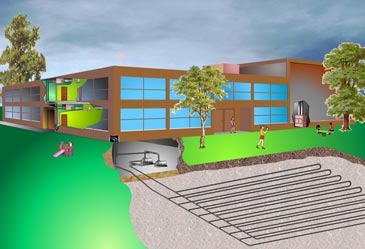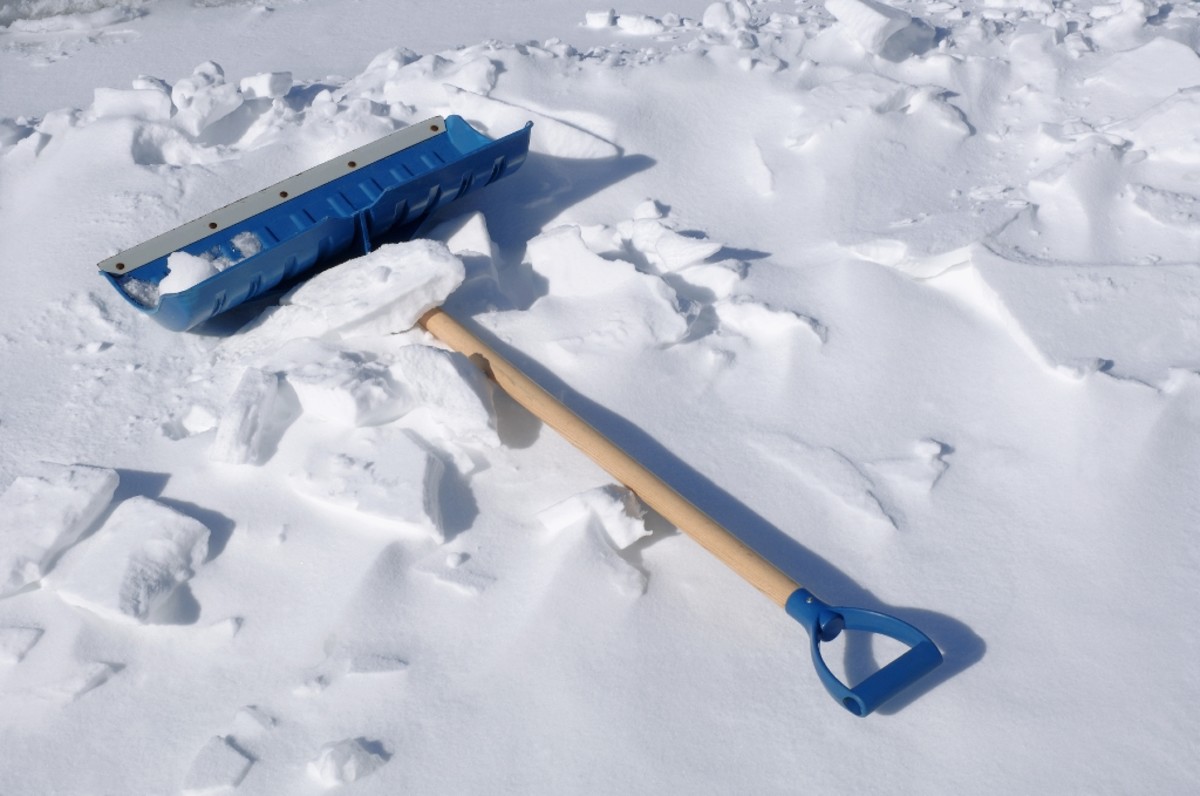How to Install a Horizontal Closed-Loop Heat Pump System

This article was authored by Ann Lyon and reprinted with permission by Cody Lyon.
Ann Lyon presently works in the Capital Program Management division at New York City’s Metropolitan Transit Authority (MTA) office as a Cost Estimating Consultant. With over twenty- five years of construction experience Ann has worked as an estimator, project manager, engineer, and program manager.
The Horizontal Closed Loop Geothermal Heat Pump System
Geothermal heat pump systems (GHPs) are becoming more and more popular with the Green Building Movement. Introduced about 60 years ago, the GHP system is one of the most efficient heating and cooling systems available today and is fast becoming the solution of choice for energy-minded builders. The benefits of using the GHP system include reduced energy consumption, water conservation, operating costs, and maintenance and replacement costs. It also eliminates the need for on-site fossil fuels. These advantages, along with enhanced system longevity, go a long way in supporting the goals of the Green Building Initiative.
Background
The GHP system utilizes the stable subterranean temperatures of the earth’s crust to provide heating and cooling to buildings. Basically, a ground source heat pump exchanges heat with the ground. In winter when the ground is warmer than the air the earth is used as a heat source. The GHP extracts natural heat from the ground and pumps it into the building’s indoor air delivery system which then distributes warm air throughout the building. In the summer, when the ground is cooler than the air, the earth is used as a heat sink. The GHP extracts the heat from the building’s indoor air stream and sends it to the ground heat exchanger.
The GHP system consists of three main elements; the heat pump unit, the heat exchanger, and the air delivery system (piping and ductwork). The heat exchanger, also known as the ground loop, moves heat between the heat pump unit and the earth. Its configuration is based on space availability, climate, soil conditions and the amount of British Thermal Units of Heat (BTUHs) the GHP must transfer.
The ground loop can be either an open or a closed loop. The open loop system uses a nearby lake or pond as both the heat source and heat sink. It transfers the water from a lake to the heat pump unit where it is used for heating and cooling the building. The discharge water is returned to the ground through a disposal reservoir, stream, or river, as approved by local statues.
The closed loop configuration circulates a solution of water and antifreeze through the heat exchanger to extract heat from the earth. The closed loop can take on one of four different configurations; the horizontal loop, the slinky loop, the vertical loop, and the pond/lake loop.
The horizontal closed loop utilizes either straight piping or coiled piping. A true horizontal ground loop system employs a single straight loop of pipe. When inadequate land is not available the loop configuration may necessitate a more dense arrangement, allowing for the loops to be connected in series or in parallel. Another option would be to create a wider trench to hold multiple rows of pipe. This technical paper focuses specifically on the horizontal closed loop configuration.
A. FACTORS TO CONSIDER
Materials
The configuration of the heat exchanger plays a major role in the project’s overall cost. A shallow horizontal loop field with a single run of pipe will require less piping than the field with multiple layers of pipe. The unit cost of the materials will be lower for those projects requiring greater quantities.
High Density Polyethylene (HDPE) pipe is the most preferred and commonly used pipe for GHP systems, because its high density makes it stronger than polyethylene piping. It is considered to be the top-of-the-line geothermal piping. Geothermal contractors may opt for a more economical material, such as polyethylene piping in order to decrease material unit costs on smaller projects.
Geographic Features
There are several geographic factors that will affect the cost of a geothermal heat pump system. These factors include; climate, available land, soil conditions, and the seasonal effect on work. The geothermal heat pump system is more commonly found in the moderate climate zone. The horizontal geothermal closed loop systems are placed in relatively shallow trenches and therefore are not economically appropriate for areas with extreme climates. Nevertheless, the GHP system has been successfully utilized in these locations.
Available land
The horizontal closed loop system requires a sufficient site area. A project located in a suburban or rural downtown area will have a larger site than a typical urban area site. Horizontal loops utilize trenches of three to six feet in depth. The cost of excavation for shallow horizontal loop fields is about half of the cost of vertical drilling. As one of the more cost effective loops to install, horizontal loops can be located in open fields, parks, or even under parking lots.
The main limiting factor for a geothermal system is the soil type found on the project site. In order for the GHP system to operate effectively the soil should have good heat transferring ability. The effectiveness of the system will depend on the ratio between the air and soil molecules. The less air and more soil molecules per inch of soil the more effective the heat transfer will be. For this reason clay soil is the most effective and dry sandy soil is the least effective. A drier soil may require a larger pipe loop system for the same heating and cooling needs. So, areas that are rich in clay soil are favorable for the horizontal ground loop system because of the large amount of trenching involved. The costs of trenching and backfill are minimal in this idea soil type system. Once the heat pump unit is in place and the loop field is finished the two are joined, filled, and thoroughly tested.
The loop configuration is the driving force behind the high initial cost of the GHP system. The ground loop field will vary from 30 to 60 percent of the project’s total cost. The cost for this system includes the labor, material, and equipment needed for the excavation of loop field, the installation of the piping, and the backfilling and compaction of the immediate area.
B. MATERIAL, LABOR, AND EQUIPMENT
Material
A geothermal closed loop consists of the piping, the coolant solution, and the heat pump unit. The Geothermal contractor will provide and install the piping and the specified antifreeze solution. The building’s heating load, soil conditions, loop configuration, and the climate will dictate the required piping, so the cost will vary from project to project.
Larger projects will require more materials such as the piping, coolant, and geotextile fabric. But the larger quantities of material will typically have a lower unit cost. The overall length of the loop will also affect the cost of the materials. A single layer loop field may extend up to 1600 feet. These longer loops require a larger diameter pipe.
The more piping used in the ground loop the greater the output of the system, however over sizing the pipe would create an unneeded additional cost for the end user. An undersized system would not meet the heating and cooling demands of the building and it will force the system to run continuously. The use of undersized pipes would result in the ground loop running colder which would diminish the amount of energy that could be extracted from the earth over a period of time. Therefore, it is critical that the proper pipe size is priced and used.
In general, the ¾” diameter HDPE pipe is easier to work with and is more economical, so it has become the most commonly used size. The header pipe, which connects the loops and then connects the loops with the system within the building, utilizes a 1-1/4” diameter HDPE pipe. For the purpose of this paper it is assumed that the ground loop fluid pump pack and valving is integrated within the heat pump.
Labor
The location, soil conditions, and season will all influence the overall labor costs. The basic labor costs will vary from location to location, as they are contingent on the local prevailing wages for the area. Additionally, productivity will decrease during the harsh winter months and in rocky soils, both of which affect the labor costs. Productivity will also decrease slightly as apprentice workers are brought on board.
Equipment
The width and the depth of the trench will determine the appropriate equipment to be used. A chain trencher or excavator is commonly used to perform this task. Horizontal directional drilling is another option, but may result in slightly higher operating costs and depending on the jurisdiction, may require the use of GPS sensors. The project’s equipment cost will depend on the contractor’s choice of equipment.
C. SPECIAL RISK CONSIDERATIONS
The construction of the loop field requires a substantial amount of trenching and/or excavation. This type of work is among the most hazardous of construction operations. Typical hazards include cave-ins, falls, equipment mishaps, and falling loads. OSHA regulations require the use of either sloping or shoring as a protective system when trenching. This regulation requires a support system for excavation and/or trenching work with a depth of 5 feet or greater.
D. MISCELLANEOUS PERTINENT INFORMATION
Clearing, grading, and excavation of the site will expose, disturb, and move the soil which increases the area’s susceptibility to erosion. Planning the site development so that these tasks are minimized facilitates the development of an erosion and sediment control plan that is appropriate and cost effective for the site. The most effective way to reduce the amount of erosion that can occur is to minimize the length of time that disturbed, non-stabilized areas are exposed. Erosion control can also reduce the clogging of streets and drainage systems and reduce the possible damage to adjacent properties.
Options for erosion stabilization include silt fencing, seeding, and mulching. Although a silt fence will not prevent erosion, it will contain soil and sediment within the perimeter walls of the construction site. Seeding and mulching, one of the most cost effective erosion control measures, will also aid in curbing erosion. While there are other erosion control options available, one or more of these three steps should be sufficient for small commercial project.








